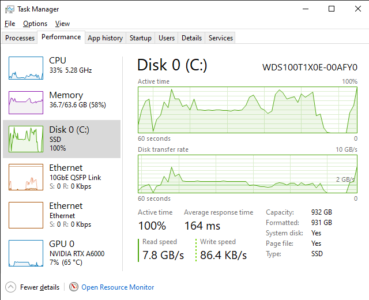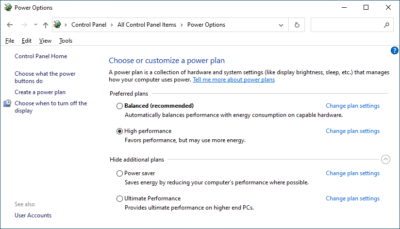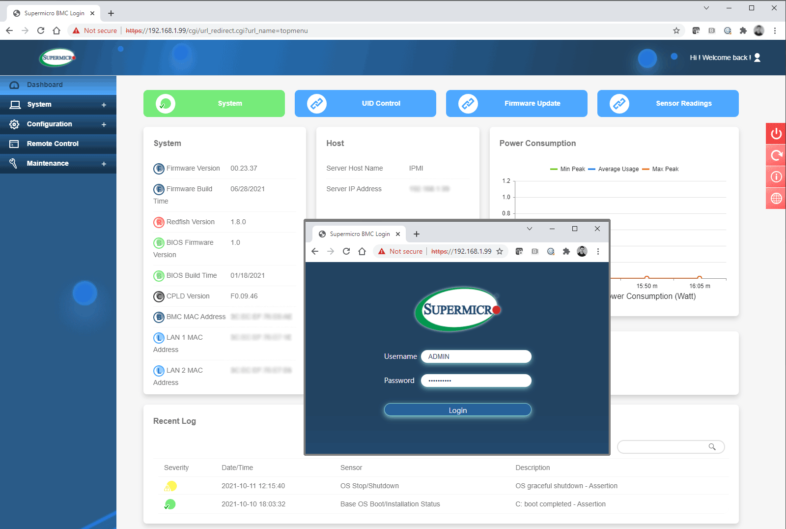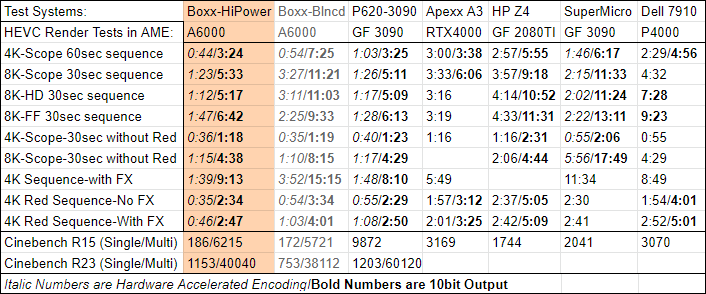BOXX’s APEXX Matterhorn system is based on Intel’s Xeon W-3300 CPU architecture, and C621A chipset, and it represents the pinnacle of Intel’s single socket system performance, with up to 38 CPU cores, 8 channels of DDR4 memory, and 64 lanes of PCIe 4.0 connectivity. The system I am reviewing came configured with the top end Xeon W-3375 CPU, sporting 38 cores, listed as running between 2.5 and 4.0 GHz, with 57MB of cache (1.5MB/Core). It has 64GB RAM spread across all 8 channels. The CPU is liquid cooled, and has a 1600Watt power supply, allowing it to support all sorts of power hungry multi-GPU configurations with its 64 PCIe lanes spread across 7 slots. It also has 4 M.2 slots, one of which came populated with a 1TB SSD. The system also shipped to me with an NVidia A6000 card in it, which is the top pro-visualization card in their formerly Quadro lineup.
 Initial Impressions
Initial Impressions
The front of the system offers dual USB3 ports, and dual USB2 ports, as well as 1/8″ jacks for speakers and microphone, and the power and reset buttons. This system also came with a full sized DVD-RW drive in the only 5.25″ bay. As a side note, it was labeled an M-Disc drive, which turns out to be a special long lasting archival optical format, which is a physical variation of DVD or Blu-Ray, readable in most normal players. Although I had never heard of it, apparently it has been available for a decade, and is one more random capability of the system.  The back side looks different than most systems, in that the motherboard is mounted on the opposite side of the case from conventional systems, placing the I/O bracket at the bottom, and the PCIe slots above that. The I/O bracket includes six USB-A ports, (four of them blue 3.0 ones) and one USB-C port (USB3.2 Gen2x2) that is not Thunderbolt compatible. (And there apparently is no option for adding support for Thunderbolt to this system, which is surprising for an Intel system.) There is an optical port and five 1/8″ audio jacks for 5.1 audio as well as microphone and line input. There is a legacy serial port, a VGA port, and three RJ-45 network jacks. The center network jack, and the VGA port are for the IPMI baseband management controller, which I will discuss later. The far jack at the bottom corner is an Intel i210AT 1GbE controller, while the one closer to the PCIe slots is an Aquantia AQC113 10GbE controller with support for N-BaseT. None of these network jacks is labeled or color coded, which is an issue I have with other SuperMicro motherboards as well.
The back side looks different than most systems, in that the motherboard is mounted on the opposite side of the case from conventional systems, placing the I/O bracket at the bottom, and the PCIe slots above that. The I/O bracket includes six USB-A ports, (four of them blue 3.0 ones) and one USB-C port (USB3.2 Gen2x2) that is not Thunderbolt compatible. (And there apparently is no option for adding support for Thunderbolt to this system, which is surprising for an Intel system.) There is an optical port and five 1/8″ audio jacks for 5.1 audio as well as microphone and line input. There is a legacy serial port, a VGA port, and three RJ-45 network jacks. The center network jack, and the VGA port are for the IPMI baseband management controller, which I will discuss later. The far jack at the bottom corner is an Intel i210AT 1GbE controller, while the one closer to the PCIe slots is an Aquantia AQC113 10GbE controller with support for N-BaseT. None of these network jacks is labeled or color coded, which is an issue I have with other SuperMicro motherboards as well.
 Right above all of this is the 1600W power supply, which has a different connector than most users will be familiar with, a C19 connector instead of the usual C14, due to the potential for the system to draw more than 15 amps from a 120V circuit. Without having 4 GPUs, there is no way my system will ever draw that much current, so I was grateful that the supplied power cable still fit into a regular 15Amp plug on my UPS.
Right above all of this is the 1600W power supply, which has a different connector than most users will be familiar with, a C19 connector instead of the usual C14, due to the potential for the system to draw more than 15 amps from a 120V circuit. Without having 4 GPUs, there is no way my system will ever draw that much current, so I was grateful that the supplied power cable still fit into a regular 15Amp plug on my UPS.
The Expansion Options-Slots and Bays
 The right side panel can be removed with two thumb screws, and hinges open from the front. Inside the system, there are all sorts of expansion options to meet your specific configuration needs. Besides the previously mentioned 7 PCIe slots and 4 M.2 slots, there are 8 SATA ports, one of which is used by the optical drive. Those ports can be used to support storage devices in four 3.5″ drive bays with tool-less trays for easy installation, and a bracket that can hold up to two 2.5″ drives, presumably SATA SSDs for most users. These are also located in spaces that are also convenient for connection to PCIe RAID cards if desired. There is also a non-functional PCIe slot that I am told is for holding an NVidia Sync card, when all of the “real” PCIe slots are in use. The only PCIe card I added to my system is a Mellanox MCX354A network interface card for my 40GbE tests.
The right side panel can be removed with two thumb screws, and hinges open from the front. Inside the system, there are all sorts of expansion options to meet your specific configuration needs. Besides the previously mentioned 7 PCIe slots and 4 M.2 slots, there are 8 SATA ports, one of which is used by the optical drive. Those ports can be used to support storage devices in four 3.5″ drive bays with tool-less trays for easy installation, and a bracket that can hold up to two 2.5″ drives, presumably SATA SSDs for most users. These are also located in spaces that are also convenient for connection to PCIe RAID cards if desired. There is also a non-functional PCIe slot that I am told is for holding an NVidia Sync card, when all of the “real” PCIe slots are in use. The only PCIe card I added to my system is a Mellanox MCX354A network interface card for my 40GbE tests.
 The system came with an A6000 GPU, which is an amazing marvel of graphics engineering, but not the best option for most video editors, who don’t need the extra $5000 price tag. Boxx also sells the system with GeForce or AMD GPU options. I usually recommend GeForce cards for most editors, unless you need a Quadro specific feature, and this is especially true now that NVidia’s Studio drivers run on both GeForce and Quadro hardware. The GeForce 3070 is probably the sweet spot for most editors, but any of the Ampere generation cards offer excellent graphics performance for editing tasks. Those doing more color and VFX work will want to invest more in GPU performance with higher tier GeForce cards, but only people working in true 3D or using other visualization tools should need to opt for the more expensive professional series cards. For example my multi-screen cinematic experience workflow for the film 6 Below a few years ago was based entirely on NVidia’s Mosaic display tiling technology, and in that case, the functionality that Quadro cards offered was worth every bit of the cost for that use case.
The system came with an A6000 GPU, which is an amazing marvel of graphics engineering, but not the best option for most video editors, who don’t need the extra $5000 price tag. Boxx also sells the system with GeForce or AMD GPU options. I usually recommend GeForce cards for most editors, unless you need a Quadro specific feature, and this is especially true now that NVidia’s Studio drivers run on both GeForce and Quadro hardware. The GeForce 3070 is probably the sweet spot for most editors, but any of the Ampere generation cards offer excellent graphics performance for editing tasks. Those doing more color and VFX work will want to invest more in GPU performance with higher tier GeForce cards, but only people working in true 3D or using other visualization tools should need to opt for the more expensive professional series cards. For example my multi-screen cinematic experience workflow for the film 6 Below a few years ago was based entirely on NVidia’s Mosaic display tiling technology, and in that case, the functionality that Quadro cards offered was worth every bit of the cost for that use case.
It is also worth noting that I was unaware that the A6000 has an EPS-12V plug instead of an 8pin PCIe cable, but includes an adapter that converts two standard 8pin PCIe power connectors into an EPS-12V plug for the card. Ironically I have had to go the other direction in my previous SuperMicro builds, adapting EPS-12V to the nearly identical looking 8Pin PCIe plug, to support GPUs in my rack mount storage systems.
 Boxx shipped the system with a 1TB Western Digital SN850 PCIe 4.0 NVMe SSD installed. While this is the third system I have tested that supports PCIe 4.0, this is the first time I have had the opportunity to test an SSD that fully utilizes that bandwidth. The drive did not disappoint, with about 5GB/s read and write performance in AJA, and nearly 8GB/s reported read performance during playback of 8K DPXs in Premiere Pro.) Uncompressed 8K DPXs require 3.5GB/s to playback, which is more than any of my previous SSDs could sustain, but because Premiere caches frames in front of the playback head, the potential read demand is much higher than that, hence the higher than strictly necessary performance numbers.)
Boxx shipped the system with a 1TB Western Digital SN850 PCIe 4.0 NVMe SSD installed. While this is the third system I have tested that supports PCIe 4.0, this is the first time I have had the opportunity to test an SSD that fully utilizes that bandwidth. The drive did not disappoint, with about 5GB/s read and write performance in AJA, and nearly 8GB/s reported read performance during playback of 8K DPXs in Premiere Pro.) Uncompressed 8K DPXs require 3.5GB/s to playback, which is more than any of my previous SSDs could sustain, but because Premiere caches frames in front of the playback head, the potential read demand is much higher than that, hence the higher than strictly necessary performance numbers.)  I was able to playback my 30 second 8K DPX sequence to my 8K display at 10bit color with a Lumetri grade and High Quality Playback enabled, without dropping frames, which I had never been able to do before. EXRs did not fare as well in any of the many possible flavors, presumably due to the processing power required for decompression and conversion from linear to video gamma color-space.
I was able to playback my 30 second 8K DPX sequence to my 8K display at 10bit color with a Lumetri grade and High Quality Playback enabled, without dropping frames, which I had never been able to do before. EXRs did not fare as well in any of the many possible flavors, presumably due to the processing power required for decompression and conversion from linear to video gamma color-space.
 The CPU is water-cooled, with tubes connected to a radiator at the lower front of the case, and large fans to cool the radiator with minimal acoustic noise. The space savings of not having a large CPU heatsink and blower, allows the power supply to sit directly above the CPU and RAM, and the power supply is connected in such a way that it can swing up out of the way to access those components if needed. Water-cooling is one of those features I have never attempted to setup on my own, and I have no desire to. The fact that Boxx has a solution completely engineered for this is one of the features that sets this system apart from its larger competitors. Water cooling should offer improvements in both acoustic performance and thermal throttling, which are both important factors for editing systems.
The CPU is water-cooled, with tubes connected to a radiator at the lower front of the case, and large fans to cool the radiator with minimal acoustic noise. The space savings of not having a large CPU heatsink and blower, allows the power supply to sit directly above the CPU and RAM, and the power supply is connected in such a way that it can swing up out of the way to access those components if needed. Water-cooling is one of those features I have never attempted to setup on my own, and I have no desire to. The fact that Boxx has a solution completely engineered for this is one of the features that sets this system apart from its larger competitors. Water cooling should offer improvements in both acoustic performance and thermal throttling, which are both important factors for editing systems.
 Power Issues
Power Issues
My initial performance tests, rendering in Adobe Media Encoder returned terrible results. Once I changed the Windows power profile from “Balanced” to “High Performance” and repeated the same renders, things improved dramatically. This resulted in the same encodes being completed in less than half of the time, so the power profile makes a huge difference, but that also bumped the idle power usage of the system from 160Watts, to 240Watts, a significant 50% increase. (The “High Performance” power plan prevents the OS from clocking back the CPU when it is not needed.) I consider this to be a pretty big deal, in regards to wasted energy, and I am hoping this can be fixed by a BIOS update, or new energy management tools in Windows 11, or something like that. To be clear, this is not a Boxx issue, but an Intel one, as a quick search online reveals that other vendors’ Xeon 3300 systems have the same results.
 Similarly, there is no option to sleep or hibernate the system, so you have to close all your apps and do a full shutdown if you want to cut power usage while the system is dormant. My understanding is that this is due to the underlying SuperMicro X12SPA-TF motherboard, which is more targeted toward the server market, where systems are expected to be always available. My storage server based workstation is the same way, and this limitation is just as annoying here as it is on there. I usually sleep my system when I head to lunch or a meeting or whatever, which pauses everything I am doing, kills the power usage.
Similarly, there is no option to sleep or hibernate the system, so you have to close all your apps and do a full shutdown if you want to cut power usage while the system is dormant. My understanding is that this is due to the underlying SuperMicro X12SPA-TF motherboard, which is more targeted toward the server market, where systems are expected to be always available. My storage server based workstation is the same way, and this limitation is just as annoying here as it is on there. I usually sleep my system when I head to lunch or a meeting or whatever, which pauses everything I am doing, kills the power usage.
System Management
Being based on a SuperMicro motherboard, it also has a full Baseband Management Controller, in the form of SuperMicro’s IPMI management system. This allows users to remotely log into the system administration interface to troubleshoot problems, even when the machine is not booted. I recommend assigning a static IP to that port, which requires a separate physical connection to your network. Browsing to that address allows you to log in and monitor or administer the system. The login used to be a generic ADMIN/ADMIN by default, but that was a powerful tool to leave unsecured by default, so SuperMicro set unique default passwords on every board, that can be found on a physical label inside the system. This new password system is well documented, but there is no reference that I can find in any of that documentation that the login name remains ADMIN in all caps. So if you get this system, or any other one with a SuperMicro motherboard, I recommend assigning the IPMI port a static IP in the BIOS, and making sure you successfully login over the network with ADMIN/[label password]. The system UI does respond well in Windows, and my Adobe apps do open up much quicker than on my other systems. (My Threadripper Pro takes over a minute to open any version of Premiere, while this Boxx system only take 20 seconds.) Once in Premiere, I immediately tried to playback 8K timelines, and the spacebar response for both starting and stopping was fast enough that I couldn’t consciously detect any lag. Illustrator and Photoshop were very responsive as well. I was able to edit large PSDs (100s of layers at 5K resolution) on my 8K monitor without any screen tearing, which I have experienced in the past, even on other high-end systems.
The system UI does respond well in Windows, and my Adobe apps do open up much quicker than on my other systems. (My Threadripper Pro takes over a minute to open any version of Premiere, while this Boxx system only take 20 seconds.) Once in Premiere, I immediately tried to playback 8K timelines, and the spacebar response for both starting and stopping was fast enough that I couldn’t consciously detect any lag. Illustrator and Photoshop were very responsive as well. I was able to edit large PSDs (100s of layers at 5K resolution) on my 8K monitor without any screen tearing, which I have experienced in the past, even on other high-end systems.
Benchmark Results
I created some 4K and 8K sequences a few years ago, and I try to always use the same content, with the same effects, and the same encoding settings for my comparison benchmarks. But the software keeps changing as well, so I use the newest version of Premiere Pro, AME, and After Effects for my render tests. These are my results compared to a few other systems I have tested over the years. For the most significant comparisons, I chose the Ryzen based Boxx A3, the Threadripper Pro based Lenovo P620, as well as my dual Xeon server conversion, and a few older options. I also included my initial set of benchmark results from the Balanced power profile to show the difference that setting made.
 After Effects has undergone some major improvements recently, and the current beta version enables Multi-Frame rendering, which is well suited to a 38Core system. My 5K background comps for Grounds of Freedom rendered 3 times faster, once multi-frame rendering was enabled. (A 20 second segment took 4 minutes instead of 12 minutes, which is a huge improvement, especially when it comes time to render the entire 5 minute composition.
After Effects has undergone some major improvements recently, and the current beta version enables Multi-Frame rendering, which is well suited to a 38Core system. My 5K background comps for Grounds of Freedom rendered 3 times faster, once multi-frame rendering was enabled. (A 20 second segment took 4 minutes instead of 12 minutes, which is a huge improvement, especially when it comes time to render the entire 5 minute composition.
Conclusions
The configuration I was reviewing currently ships for about $17500, which is a lot of money for a computer. At least that was my opinion until I looked at Apple’s prices for similarly configured Mac Pro towers for $20K, which are based on the previous generation architecture (28 Core Xeon W processors with 6 channel RAM, etc.). And while $17,500 is still a lot of money, $5000 of that price is for the A6000 card, which few people really need, and $4000 of that was for the 38 core CPU which not everyone needs either. A different configuration of this Matterhorn could be ordered for half that price, and still support all the same PCIe and RAM expansion options. But even though this machine is a comparable system to the Mac Pro, and exceeds it in nearly every metric, this might not be the best choice for the average editor. (Similarly I don’t think the MacPro is the best choice for most OSX based editors, but they have far fewer options available to them.) There are other systems, including other options from Boxx, with lower levels of peak performance, for much less money. The lack of Thunderbolt support in this system is a factor as well, as that interface is important for a number of different media workflow options. 
Consumer system architectures, like Ryzen and Core i9, offer much better performance per dollar, and the majority of video editors will be better served by those platforms. Lower tier systems now support top performing GPUs, 8 or more CPU cores, and at least 128GB RAM, really raising the level you can reach before you are forced to step up to that next class of system. And once you are stepping up beyond that consumer tier, AMD’s Threadripper platform would be the next option to evaluate, before you pull out the big bucks for this model at the top of the hierarchy. Now that recommendation is more about the differences between Intel and AMDs options, than anything Boxx has done. Boxx offers systems from both Intel and AMD, at each of these different performance classes. I have now tested their lowest end AMD solution in the A3, and this top end single-socket Intel solution. And while this system is amazingly powerful, for most editors, the lower tier solution will offer far more bang for their buck. But those lower tier options don’t leave nearly as much possibility for scaling up to higher performance, with more RAM and GPUs. The Apexx Matterhorn system is really designed for users who need the performance of 4 top end GPUs, and TBs of RAM, so people at the top end of color grading and 3D VFX workflows, or creating VR content, might find this to be a compelling option. Applications like Nuke or Autodesk’s offerings may see greater performance increases from this hardware than I am seeing in Adobe applications. So if your workloads scale up with more cores and RAM, and you need greater expandability, then Boxx has put together quite the system, and this Apexx Matterhorn may be the ideal solution for you.

